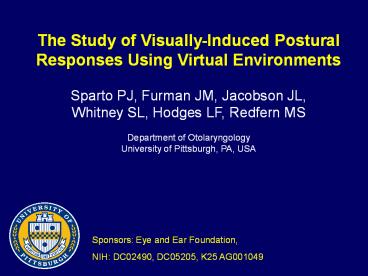The Study of Visually-Induced Postural Responses Using Virtual Environments - PowerPoint PPT Presentation
Title:
The Study of Visually-Induced Postural Responses Using Virtual Environments
Description:
Title: PowerPoint Presentation Author: Patrick Sparto Last modified by: Patrick Sparto Created Date: 1/9/2002 3:41:14 AM Document presentation format – PowerPoint PPT presentation
Number of Views:172
Avg rating:3.0/5.0
Title: The Study of Visually-Induced Postural Responses Using Virtual Environments
1
The Study of Visually-Induced Postural Responses
Using Virtual Environments Sparto PJ, Furman
JM, Jacobson JL, Whitney SL, Hodges LF, Redfern
MS Department of Otolaryngology University of
Pittsburgh, PA, USA
Sponsors Eye and Ear Foundation, NIH DC02490,
DC05205, K25 AG001049
2
Collaborators Rolf Jacob, MD Kathryn Brown,
MS, PT Jeffrey Jasko, BS Leigh Mahoney, MS Chad
Wingrave, MS
3
Visually-Induced Postural Sway Research
- Vestibular disorders (Redfern and Furman, 1994)
- Anxiety disorders (Jacob et al., 1995)
- Healthy elders (Borger et al., 1999)
- Adaptation (Loughlin et al., 1996, Loughlin and
Redfern, 2001)
4
Limitations
- Single rear-projected screen
- Restricted in field of view (60 deg)
- Not able to study peripheral motion cues
- Modified Equitest platform
- Pitch motion only
- Frequency and amplitude range limited
5
Balance NAVE Automatic Virtual Environment (BNAVE)
- Spatially-Immersive VR Facility used to generate
moving visual environments - Can control many factors
- Field of view (180o H x 110o V)
- Spatial and temporal characteristics of movement
- Spatial frequency
- Monoscopic stereoscopic
6
BNAVE Layout
7
Sensory Integration
- Modified Neurotest posture platform
- Pitch and A-P translation
- Treadmill
- Galvanic Vestibular Stimulation
8
(No Transcript)
9
(No Transcript)
10
Subjects
- Healthy Adults (CON)
- 5 Males, 6 Females
- Age 32 - 66 years, mean 49 11 yrs
- No abnormalities on clinical vestibular tests
- Adults with Unilateral Vestibular Loss (UVL)
- 5 Males, 6 Females
- Age 32 - 66 years, mean 49 11 yrs
- 10 - 72 months post vestibular n. section
11
Stimulus
- Frequency of Movement
- 0.1 Hz
- 0.25 Hz
- RMS velocity was 1.2 m/s for both freq.
12
(No Transcript)
13
Data Analysis
- A-P Head Position sampled at 20 Hz using
electromagnetic tracker - RMS amplitude of sway computed at stimulus
frequency - Linear, Time-Invariant and Dynamic Systems
Analyses
14
Adults CON v. UVL
15
Phase-locked
16
Not Phase-locked
17
Phase-locking behavior
18
90
Phase v. Frequency
3
60
120
2
30
150
1
180
0
210
330
UVL 0.1
CON 0.1
UVL 0.25
240
300
CON 0.25
270
19
90
CON v. UVL 0.1 Hz
3
60
120
2
30
150
1
180
0
210
330
UVL 0.1
CON 0.1
240
300
270
20
90
CON v. UVL 0.25 Hz
3
60
120
2
30
150
1
180
0
210
330
UVL 0.25
240
300
CON 0.25
270
21
Conclusions
- Peripheral stimulus induces sway in ½ subjects
at 0.1 Hz, and 1/3 subjects at 0.25 Hz - Subjects with compensated UVL sway the same
amount as controls - Subjects with UVL have different timing at 0.25
Hz
22
Adults v. Children (8-12 y.o.)
- Healthy Adults (CON)
- 5 Males, 6 Females
- Age 32 - 66 years, mean 49 11 yrs
- No abnormalities on clinical vestibular tests
- Children
- 5 Males, 5 Females
- Age 8 - 12 years, mean 10 1 yrs
- No abnormalities on clinical vestibular tests
23
Healthy Adults v. Children
24
Conclusions
- Greater sway at higher frequencies
- Children aged 8-12 years still do not show adult
pattern of visually-induced sway - Vestibular and somatosensory threshold for
postural control may be higher
25
Conclusions
- Visually-induced postural sway is a complex
problem, dependent on many factors - visual field of view
- optic flow structure
- spatial and temporal frequency of stimulus
- Relevant to many clinical problems
26
Current Areas of Research
- Visual Influences in Height Phobia
- Visual Influences in Migraine
- Vestibular Rehabilitation using VR
27
(No Transcript)
28
(No Transcript)































